

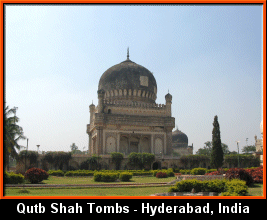
Once again I found myself in a country that was never really on my list of “must see” countries: India. As I heard it described in one of those travel books that you always seem to pickup when traveling to a new country: “...India is both exactly what you expect and nothing like you expect...” As usual, in my pre trip mental wanderings I conjured up lots of different images: Turban-clad snake charmers, Elegant Raj palaces with lots of British folk enjoying high tea, lots of little children attempting to relieve me of my possessions, etc. The real things was all of these and none of these at the same time. Let's start at the beginning. As they say, “Half the fun is getting there!”
When traveling to Asia from California, you
have to options: Fly east, or fly west. I chose to fly east for a number of
reasons: 1 - If you fly west you lose a day because of the International Date
Line. 2 - the airline on which I attempt to accumulate frequent flier miles
does not fly west. 3 - I could arrange my layovers in such a way that allowed
me a day in Paris on
the trip back. This decision made (and tickets booked), I began my long
journey. First leg: San Francisco to JFK. Great flight....no problems
whatsoever (it helped that I was able to bump myself to first class for this
leg). Total elapsed time: 5 hours. Next leg: JFK to Paris, Charles de Gaulle.
Let's start by saying that to say this flight was packed is an understatement.
Unable to secure my preferred window seat, I was in an aisle seat next to the
window in a rather Spartan MD-11.
For those of you not familiar with this aircraft, it seems to be the cheapest
large capacity aircraft out there. It can hold lots of people, but offers very
little in the way of luxuries (i.e. in seat video, multiple galleys, etc.):
It's basically a box with wings. I've done quite a few European flights in my
time and I am usually pretty haggard but functional by the time I reach Europe
(as was the case this time). Total flight time: 7 hours 10 minutes.
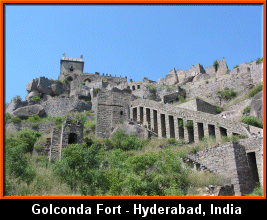 Usually this the point in most journeys where you are
excited to have arrived at your destination and eager to go out and see things.
Unfortunately for me, the only thing I had to look forward to was another 18
hours of flying to reach my final destination. Oh well. Unfortunately, the
flight from JFK actually was continuing to Mumbai (Bombay) so I could only look
forward to boarding the exact same plane from which I had just disembarked.
Delta flights (and most other Air France flights) arrive into the 'old' (and
rather dingy) halls (read as 'Terminals' - terminals A, B, C, and D) at CDG.
Flights connecting to other parts of Europe usually depart from the
architecture marvel known as 'Hall F'. I love this terminal (see my pictures from
Lisbon, Portugal to prove
it). You may have see this terminal and not even known it if you have ever seen
the video for U2's "Beautiful Day" which was filmed in this Hall. But
I digress...
Usually this the point in most journeys where you are
excited to have arrived at your destination and eager to go out and see things.
Unfortunately for me, the only thing I had to look forward to was another 18
hours of flying to reach my final destination. Oh well. Unfortunately, the
flight from JFK actually was continuing to Mumbai (Bombay) so I could only look
forward to boarding the exact same plane from which I had just disembarked.
Delta flights (and most other Air France flights) arrive into the 'old' (and
rather dingy) halls (read as 'Terminals' - terminals A, B, C, and D) at CDG.
Flights connecting to other parts of Europe usually depart from the
architecture marvel known as 'Hall F'. I love this terminal (see my pictures from
Lisbon, Portugal to prove
it). You may have see this terminal and not even known it if you have ever seen
the video for U2's "Beautiful Day" which was filmed in this Hall. But
I digress...
The flight to Mumbai was....well....for lack of a better word...long. Fortunately for me, me seat companion (who was also with me from NY to Paris) was from India, but works for Lucent in New Jersey. He was more than happy to fill me in on bits and pieces of trivia about India. Despite my misgivings about flying over several countries that the United States does not get along with so well (Iraq, Iran, Afghanistan and Pakistan), the flight arrived in Mumbai in one piece! Total flight time: 8 hours and 19 minutes.
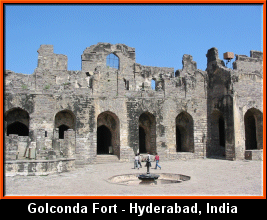 Let's look backwards for a moment. I left San Francisco at 7:00am (of course, I had to
get up about 3:30 to make it to the airport to check-in, go through security, etc.). 5
hours to New York + layover (about 2 hours), 7 hours from New York to Paris + layover
(about 2 hours) and 8 and a half hours to Bombay. According to my math, I had been
"traveling" for about 28 hours at this point. I was tired. I wanted a
shower. I wanted to sleep in a totally horizontal position. But alas, this was
not to be the case...instead I was facing another 3 hour layover plus the
prospect of getting from the Mumbai "International" airport to the
Mumbai "Domestic" airport for my connection to Hyderabad, an hour and
a half flight away.
Let's look backwards for a moment. I left San Francisco at 7:00am (of course, I had to
get up about 3:30 to make it to the airport to check-in, go through security, etc.). 5
hours to New York + layover (about 2 hours), 7 hours from New York to Paris + layover
(about 2 hours) and 8 and a half hours to Bombay. According to my math, I had been
"traveling" for about 28 hours at this point. I was tired. I wanted a
shower. I wanted to sleep in a totally horizontal position. But alas, this was
not to be the case...instead I was facing another 3 hour layover plus the
prospect of getting from the Mumbai "International" airport to the
Mumbai "Domestic" airport for my connection to Hyderabad, an hour and
a half flight away.
In reality, the "domestic" and "international" airports not separate airports, but different terminals on different sides of the same airport with no easy way to get between them. My contacts in India told me that I had two options: I could exchange some dollars for rupees and catch a taxi to the other terminal, or I could take the Jet Airways shuttle. Working on too little sleep and not wanting to go through the hassle of exchanging currency, I opted for the Jet Airways shuttle. As I made my way from the jet way to collect my luggage, I got the peculiar feeling that I wasn’t in Kansas anymore (apologies to Dorothy).
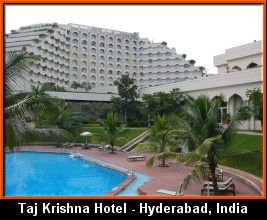 The arrival halls of Mumbai International are very
Spartan, if not downright shabby. Immigration was relatively straightforward
despite the fact that the immigration official pointed out that my passport had
become quite worn and that my photograph looked like it was coming out of the
passport. The press of humanity in Baggage claim was beyond belief. Apparently,
what I'd always heard about Asia applied on the Indian subcontinent as well: Because
there are so many people, there is absolutely no respect for personal space. I
nearly crushed several small women in my attempt to exit baggage claim. I feel
absolutely no remorse for this, however since nearly everyone else seemed to
crush 5 times that number.
The arrival halls of Mumbai International are very
Spartan, if not downright shabby. Immigration was relatively straightforward
despite the fact that the immigration official pointed out that my passport had
become quite worn and that my photograph looked like it was coming out of the
passport. The press of humanity in Baggage claim was beyond belief. Apparently,
what I'd always heard about Asia applied on the Indian subcontinent as well: Because
there are so many people, there is absolutely no respect for personal space. I
nearly crushed several small women in my attempt to exit baggage claim. I feel
absolutely no remorse for this, however since nearly everyone else seemed to
crush 5 times that number.
I breathed a little easier (as I always do after clearing Immigration and Customs in any country, including the United States) after having my luggage pass the security screening and I was making my way out of the airport. Even the forewarning in baggage claim could not have prepared me for what I was about to experience. I walked out of the airport expecting what I would see at any other airport in the world: Neat, orderly taxi ranks, parking lots and busses. I was not prepared for the estimated 5,000 people crowding the entrance to the airport (at 1:00am). I stood momentarily stunned, at a complete loss for words, until the press of the crowd behind me propelled me into the throbbing mass of people. I fought my way to the edge of the crowd and started walking down a sidewalk that paralleled the terminal...out of the frying pan and into the fire.
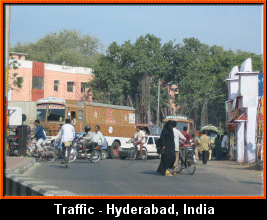 Immediately I was beset upon by touts for taxis.
Having already decided to take the Jet Airways shuttle, I started off by
politely declining their offers of service. Soon, I had to become rather
forceful. They tried to explain to me that I only had 3 hours to get to the
domestic terminal and that I would not make it in time if I took the shuttle. I
said..."No, thanks." I said, "I don't have any Indian Currency"
(at which point I was assured that they would gladly take dollars - yeah...I'll
just bet you would). Soon my replies of "No thanks" turned into
"Just get away from me"! Mercifully, I followed some other travelers
who looked like they knew where they were going and found my way to a very
modern bus that would take me to the next terminal.
Immediately I was beset upon by touts for taxis.
Having already decided to take the Jet Airways shuttle, I started off by
politely declining their offers of service. Soon, I had to become rather
forceful. They tried to explain to me that I only had 3 hours to get to the
domestic terminal and that I would not make it in time if I took the shuttle. I
said..."No, thanks." I said, "I don't have any Indian Currency"
(at which point I was assured that they would gladly take dollars - yeah...I'll
just bet you would). Soon my replies of "No thanks" turned into
"Just get away from me"! Mercifully, I followed some other travelers
who looked like they knew where they were going and found my way to a very
modern bus that would take me to the next terminal.
Despite the influence of the British who will happily queue for hours for anything, the queuing process for the shuttle bus was nothing short of chaotic. Finally aboard the mercifully air conditioned bus (standing room only, of course), it began its 20 minute drive "around the corner" to the domestic airport. The area of Bombay immediately surrounding the airport reminds me somewhat of the are around Sao Paulo's airport, complete with shacks and beggars. All of this was a blur in my jet-lag fogged mind. When we finally reached the relatively deserted domestic terminal (and I soon realized that anytime you see fewer than 1,000 people in any one place in India, you are about as remote as you are ever going to be in the country), I was very impressed with the folks unloading the bus: they made everyone stand back from the bus and then brought off the luggage one piece at a time and would not unload another bag until the previous one had been personally handed to the owner. This ensured that I was the one who actually claimed my bags.
 I next got to experience firsthand the concept of
baksheesh. I rather official looking gentleman (almost none of the airport
personnel wore any type of identification or uniform making it difficult to
decide who was there to help and who was there to scam) asked me what flight I
was taking and quickly whisked me pass the line of people waiting to go through
security. Once through security he further escorted me to the Jet Airways
ticket agent who promptly issued my ticket. My one and a half hour flight to
Hyderabad was to be first class and the ever accommodating gentleman eagerly
escorted me to the first class lounge to await my flight's departure...I tipped
him $20. It was worth it: After all of that flying, anything to make my life
easier was well worth it.
I next got to experience firsthand the concept of
baksheesh. I rather official looking gentleman (almost none of the airport
personnel wore any type of identification or uniform making it difficult to
decide who was there to help and who was there to scam) asked me what flight I
was taking and quickly whisked me pass the line of people waiting to go through
security. Once through security he further escorted me to the Jet Airways
ticket agent who promptly issued my ticket. My one and a half hour flight to
Hyderabad was to be first class and the ever accommodating gentleman eagerly
escorted me to the first class lounge to await my flight's departure...I tipped
him $20. It was worth it: After all of that flying, anything to make my life
easier was well worth it.
Next subject: Airport Security. In this post-911 world, the American press is up in arms about increased airport security. India is a country that has been facing terrorism almost longer than America has been a country: The are (practically) at war with Pakistan over the Punjab region, conflict in Nepal is spilling over into India, and several pockets around Bangladesh (formerly East Pakistan, for all intents and purposes) seem to think that now is the time for their independence. Let me tell you this: These folks know a thing or two about security and what we have in the United States is not Airport Security: Before the flight from Mumbai to Hyderabad, I went through an exhausting security regimen. First I went through a hand (wand) security check, at which point each piece of carry on baggage was affixed with a tag and stamped. When I got to the gate, after they had validated my ticket, the tag was stamped again. Then, after leaving the gate, I was "patted down" by hand. Now that's security.
After my exhausting 30 or so hours of travel, I
arrived at the Hyderabad airport completely exhausted. But soon the curiosity
of being in a new place kicked in and I found myself quite excited. My driver
and a representative from Satyam (where I would be working) met me at the
airport and whisked me through deserted streets (it was 4:30am) to the
luxurious Taj Krishna hotel. One thing I must say upfront about the Indian
people: They are incredibly polite and very hospitable. Dwinder from Satyam
even assisted me in checking in and helped me get to my room. We agreed on a
time for my driver to pick me up from the Hotel later in the morning to do some
sightseeing. After the obligatory phone calls to my wife and family to let them
know that I had arrived alive, I found myself unable to sleep and instead
watched the sun rise over Hussain Sagar and the city of Hyderabad.
My driver Syed arrived about 11:00am to take me on a brief sightseeing tour. We started off at the official symbol of the city of Hyderabad: the Charminar. The Charminar is a beautiful mosque in the old Muslim section of town at the intersection of 4 main boulevards. The monument is set in a busy square, surrounded my the Lad Bazaar: vegetables, pearls, bangles, etc. can all be purchased in this market surrounding this square. This is the first clue that the visitor is somewhere exotic. The rush of three-wheeled auto-rickshaws, cars, busses and scooters, the sights and smells of the bazaar, the soft black shapes of burka-clad women and the constant noise and chatter of the market all contribute to a totally (to my eyes) foreign landscape. We parked the car, and got out the camera to take some pictures of the Charminar. The name 'Charminar' actually means “4 minars” or minarets. This imposing landmark was built by Quili Qutub Shah around 400 years ago out of granite and lime mortar.
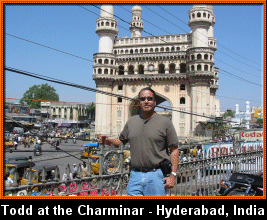 We continued on to the Qutb Shahi tombs on the
outskirts of the city. These tombs are very much like the pictures that I have
seen of the Taj Mahal (the one in India, not the one in Atlantic City), albeit
much less grand. There are 7 tombs total built over a number of years in the
16th century. They are the burial places of the rulers of Golconda fort.
Originally, these graceful domes where tiled with blue and green tiles, though
these have fallen off over the years. One of the tombs actually houses the
remains of the ruling mother of the kings (apparently, she was greatly
revered). The tombs are spread out over a number of acres and are surrounded by
a landscaped park. There was a small entrance fee, and my driver, Syed acted as
a guide. There are plenty of small boys inside the park who are more than eager
(in fact, you need to rather forcefully say no) to give personal tours or sell
you information about the tombs. Had my driver not been a more than capable
guide, I would have considered doing this: This is how many of them make a
living, and given the disparity of income, you can really make someone's day
(or month) and get a great tour for about $5.
We continued on to the Qutb Shahi tombs on the
outskirts of the city. These tombs are very much like the pictures that I have
seen of the Taj Mahal (the one in India, not the one in Atlantic City), albeit
much less grand. There are 7 tombs total built over a number of years in the
16th century. They are the burial places of the rulers of Golconda fort.
Originally, these graceful domes where tiled with blue and green tiles, though
these have fallen off over the years. One of the tombs actually houses the
remains of the ruling mother of the kings (apparently, she was greatly
revered). The tombs are spread out over a number of acres and are surrounded by
a landscaped park. There was a small entrance fee, and my driver, Syed acted as
a guide. There are plenty of small boys inside the park who are more than eager
(in fact, you need to rather forcefully say no) to give personal tours or sell
you information about the tombs. Had my driver not been a more than capable
guide, I would have considered doing this: This is how many of them make a
living, and given the disparity of income, you can really make someone's day
(or month) and get a great tour for about $5.
After touring the tombs we decided to have
some lunch. Ah...the food. I could write pages and pages about the food.
Hyderabad has a curious mix of cuisine. The city is largely Muslim, despite
most of the surrounding area being Hindu. Not only do the two religions
peacefully co-exist, but the combination of their foods (meat for the Muslims,
vegetarianism for the Hindus) yields an amazing variety of choices. My
favorites? Chicken
65 - boneless chicken marinated in a combination of spices (apparently 65
of them), Butter
Chicken - chicken marinated in a mixture of mild spices and fried, and
anything with Paneer
(which is deep fried cottage cheese - I know, it sounds rather strange, but is
fantastic, especially served with spinach and mild curry). On my first day, we
went to a delightful little outdoor restaurant in the upscale Banjara Hills
district called 'Our Place'. 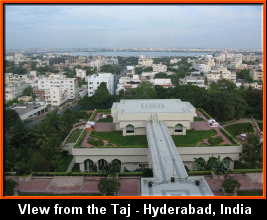 I learned the all important dining skill: eating with
your right hand only. The chicken 65 and butter chicken come in small cubes
with plenty of sauce. The idea is to use your right hand only to tear off a bit
of Roti (which is an unleavened flat bread that is reminiscent of a tortilla)
and use this bit of bread to pick up a piece of chicken. Our Place even
provides a small bowl of lemon water to rinse your hand (singular, not plural -
remember, you're only using your right hand here) at the end of the meal.
Finally, jet lag caught up with me and I retired to my hotel and slept for
about 15 hours.
I learned the all important dining skill: eating with
your right hand only. The chicken 65 and butter chicken come in small cubes
with plenty of sauce. The idea is to use your right hand only to tear off a bit
of Roti (which is an unleavened flat bread that is reminiscent of a tortilla)
and use this bit of bread to pick up a piece of chicken. Our Place even
provides a small bowl of lemon water to rinse your hand (singular, not plural -
remember, you're only using your right hand here) at the end of the meal.
Finally, jet lag caught up with me and I retired to my hotel and slept for
about 15 hours.
The next day (Monday) was a national holiday in India called Diwalli, which (to the western eye) looks to be a combination of Christmas, New Years and July the 4th (for us Americans). Basically, this is a "festival of light" which involves the lighting of candles at night and many, many fireworks! In fact, the only other place that I have been where fireworks are so available (and legal) was Venezuela at Christmas time. I am surprised a little bit at this: In California, most "home use" fireworks have been banned because of the fire danger they pose. I took lots of pictures from my hotel room of incredible bursts over Hussain Sagar, but unfortunately, my camera was so good, it also picked up on the water spot stains on the window! >
During Monday, we visited the Charminar again and walked around the market. I also bought some pearls for my wife, mother and sister. Apparently, with the recent problems in Iraq, Hyderabad has become the world's largest dealer of pearls. Previously, Basra in Iraq held this honor, but UN sanctions have put a stop to this. I was able to pick up some great strands (white for my mom and sister and a gorgeous double strand of black and white pearls for my wife - all with matching earrings for about $200).
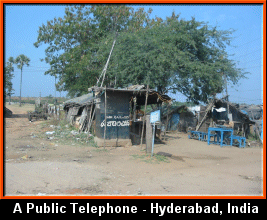 We then headed out to Golconda
Fort. Golconda is an enormous double-walled fort built on a large rocky
hill. The fort was built in 1525 on top of a 120 meter tall granite hill (about
400 feet for the metrically
challenged by the Qutub Shah kings (the structure was originally started in
the 13th century as a mud fort built around an idol that a wandering shepherd
boy found). The fort is surrounded by an 11 kilometer (6.8 miles for the
metrically challenged) outer wall that completely encompasses the fort and the town
of Golconda. To get to the fort, you need to drive through a gate in the outer
wall. These outer walls are impressive...I would estimate that they are about
20 feet thick, and about 60 feet tall. I would (as many other invaders no doubt
did) think twice about attacking this place. As if the outer walls were not
enough of a deterrent, the inner walls are about the same thickness and height,
complete with wooden doors with large, protruding iron spikes to deter
elephants from trying to break down the doors.
We then headed out to Golconda
Fort. Golconda is an enormous double-walled fort built on a large rocky
hill. The fort was built in 1525 on top of a 120 meter tall granite hill (about
400 feet for the metrically
challenged by the Qutub Shah kings (the structure was originally started in
the 13th century as a mud fort built around an idol that a wandering shepherd
boy found). The fort is surrounded by an 11 kilometer (6.8 miles for the
metrically challenged) outer wall that completely encompasses the fort and the town
of Golconda. To get to the fort, you need to drive through a gate in the outer
wall. These outer walls are impressive...I would estimate that they are about
20 feet thick, and about 60 feet tall. I would (as many other invaders no doubt
did) think twice about attacking this place. As if the outer walls were not
enough of a deterrent, the inner walls are about the same thickness and height,
complete with wooden doors with large, protruding iron spikes to deter
elephants from trying to break down the doors.
Once inside the gates, you arrive at the "clapping station". I'm sure that there is a formal name for this place, but "clapping station" is a fitting term. If you stand in the center of this domed portico and clap your hands, the clapping sound can be heard up on the top of the hill at the 'Bala Hissar' almost a kilometer away. This is apparently accomplished by concentrating the sound of the clap at the top of the dome, which reflects downward to the floor, which bounces "up the hill". Pretty cool! Proceeding up the hill from the entrance are the open air guard barracks. In the barracks, there is a huge iron block weighing 200 kilos (over 400 pounds). Apparently, each day guards were required to lift this block off the ground. If you weren't able to (I tried, and couldn't even rock this thing off the ground), you were dismissed from Guard duty.
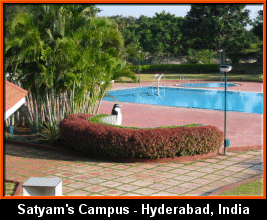 Continuing along the "common way" up and
around the right side of the fort, you can really see the details in the
construction of the fort. All of the stones were laid loose (no mortar). The
bottom row of stones on the outside walls were nailed into the granite base
with huge iron spikes to keep them in place. The "common way" is the
way normal people would travel from the bottom of the fort to Durbar Hall at
the top, where the king would hold court in this light and airy palace. Think
steps....lots of steps! On the way up, you pass the fort's jail where prisoners
were kept completely out of the light (food was lowered via a hole in the
ceiling). From the top of the fort (the Durbar Hall) you can see the Tombs, and
on a clear day, the Charminar in Hyderabad. Speaking of which, there is a tunnel
from the top of the fortress (the Durbar Hall) all the way to the Charminar in
Hyderabad (11 km), but it has been deemed 'unsafe' by city officials and has been
closed. I quess the prospect of walking 11km in the dark through spiders, snakes
caved-in sections and God knows what else is not very safe!
Continuing along the "common way" up and
around the right side of the fort, you can really see the details in the
construction of the fort. All of the stones were laid loose (no mortar). The
bottom row of stones on the outside walls were nailed into the granite base
with huge iron spikes to keep them in place. The "common way" is the
way normal people would travel from the bottom of the fort to Durbar Hall at
the top, where the king would hold court in this light and airy palace. Think
steps....lots of steps! On the way up, you pass the fort's jail where prisoners
were kept completely out of the light (food was lowered via a hole in the
ceiling). From the top of the fort (the Durbar Hall) you can see the Tombs, and
on a clear day, the Charminar in Hyderabad. Speaking of which, there is a tunnel
from the top of the fortress (the Durbar Hall) all the way to the Charminar in
Hyderabad (11 km), but it has been deemed 'unsafe' by city officials and has been
closed. I quess the prospect of walking 11km in the dark through spiders, snakes
caved-in sections and God knows what else is not very safe!
Golconda has a really ingenious system for providing the fort with fresh water. Water was brought into a series of three holding tanks at varying altitudes within the fort from Hussain Sagar (the man made lake between Hyderabad and Secunderabad - one of the largest man made lakes in Asia), almost 11 kilometers away. Water was then pumped into the successive reservoirs. When the water reached the top of the fort, it was routed into clay pipes (the remains of which can be seen attached to the walls on the "king's way" down to the palace. This allowed for "gravity powered" fountains in the palace below.
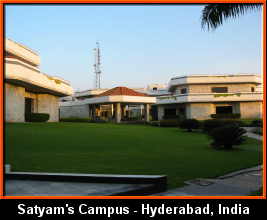 The "king's way" is a series of steep steps
on the left side of the fort. The king was brought up and down these stairs
(they were reserved exclusively for royalty) each day by porters. The remains
of the palace offer a small glimpse into what must have been an enormous domed
structure (the dome no longer remains). Most of the ruins of the palace are off
limits to the visitor (although, you can hear the screeches of bats, and the
fluttering in of their soft wings in these dark areas), but the main courtyard
and guard chambers can be seen. The guard chambers also feature a unique
acoustic trick: You can face a corner of the chamber and whisper into the wall
and a person facing the opposite corner on the other side of the chamber can
hear your whisper, while someone in the center of the chamber cannot. Another
cute side effect was that the king (whose chambers were above the guard's)
could hear everything that was said below! I imagine that this thwarted more
than one rebellion!
The "king's way" is a series of steep steps
on the left side of the fort. The king was brought up and down these stairs
(they were reserved exclusively for royalty) each day by porters. The remains
of the palace offer a small glimpse into what must have been an enormous domed
structure (the dome no longer remains). Most of the ruins of the palace are off
limits to the visitor (although, you can hear the screeches of bats, and the
fluttering in of their soft wings in these dark areas), but the main courtyard
and guard chambers can be seen. The guard chambers also feature a unique
acoustic trick: You can face a corner of the chamber and whisper into the wall
and a person facing the opposite corner on the other side of the chamber can
hear your whisper, while someone in the center of the chamber cannot. Another
cute side effect was that the king (whose chambers were above the guard's)
could hear everything that was said below! I imagine that this thwarted more
than one rebellion!
One of the coolest things about Golconda Fort was the "night show". The show consists of a narrative about the history of the fort accompanied by lights (which light up different sections of the fort to accompany the narrative) and music. This is a definite "must see" despite the virtual sea of mosquitoes that come out after dark. No wonder there are bats in the uninhabited sections of the fort...they must feast after dark!
Unfortunately, it was not all
"play" on this trip. Most of my time was spent out at the Satyam
campus, training programmers on how our software (in my particular area of expertise)
works. 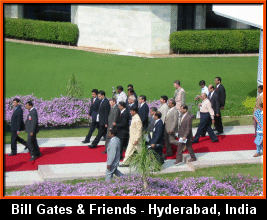 These folks were great...very intelligent, incredibly
polite and very hard working. Their campus is amazing...it's about 25 miles
outside of Hyderabad and is pretty much self contained. They have an Olympic
sized swimming pool, hot tubs, saunas, weight rooms, dorms, ping pong tables,
pool tables, an aviary, a private deer park, and (surprise) a 9-hole golf
course on their campus. Very cool, although I declined playing a round or two
of golf, as I have a deep fear of snakes (which apparently the course has in
spades).
These folks were great...very intelligent, incredibly
polite and very hard working. Their campus is amazing...it's about 25 miles
outside of Hyderabad and is pretty much self contained. They have an Olympic
sized swimming pool, hot tubs, saunas, weight rooms, dorms, ping pong tables,
pool tables, an aviary, a private deer park, and (surprise) a 9-hole golf
course on their campus. Very cool, although I declined playing a round or two
of golf, as I have a deep fear of snakes (which apparently the course has in
spades).
All of Hyderabad (and other cities in India too) was busy while I was there preparing for a visit by none other than Bill Gates. In fact, I had to cancel my last day of classes because Mr. Gates was visiting the campus and would be speaking in the room below the training facility. Gates was in India to promote Windows (of course) and to donate funds to fight AIDS. In Hi-Tec City (an area of high tech business including Oracle, Microsoft and others), Mr. Gates was planning on increasing staff from 50 to 500 over the next 4 years. He also gave Hyderabad a check for 50 million for increased AIDS awareness. I was able to get a few pictures of Bill (he was also staying at my hotel, a couple of floors above me), as he walked from his helicopter to the Satyam offices. All over the city, people were busy repaving roads and repairing infrastructure for his arrival. Almost every overpass on every road had a banner welcoming Gates. The Beatles once said that the were more popular than Jesus Christ. I think Bill could get away with that statement as it applies to India. In many ways he is their savior: The IT revolution has provided a way for Indians to make a lot of money without the physical labor so prevalent in many third world nations.
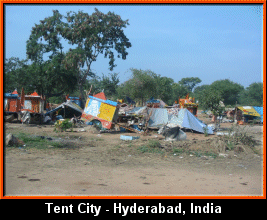 No matter where I go in the world (including the
United States), I see both the good and the bad in a given location. Hyderabad
is certainly exotic, between the bazaars, markets, the tombs and Golconda fort.
But (inevitably) it also has its share of problems. I was totally unprepared
for the sheer number of people in Hyderabad (or in India in general). This Asian
subcontinent has 1 billion plus people, and they have inherited some of the
basic problems that stem from over population such as incredible amounts of
pollution, and some truly horrible living conditions. Hyderabad is a living,
breathing oxymoron: You have one of the most advanced IT communities in all of
India, and right next door, you have people living in cardboard hovels with
open sewers. Even in the upscale Jubilee and Banjara Hills area, you have
million dollar mansions right next to "tent cities". If India can
overcome its population and pollution, the rest of the world had better get its
act together: these people work hard, and are very intelligent. They could (and
perhaps will) rule the world's IT marketplace.
No matter where I go in the world (including the
United States), I see both the good and the bad in a given location. Hyderabad
is certainly exotic, between the bazaars, markets, the tombs and Golconda fort.
But (inevitably) it also has its share of problems. I was totally unprepared
for the sheer number of people in Hyderabad (or in India in general). This Asian
subcontinent has 1 billion plus people, and they have inherited some of the
basic problems that stem from over population such as incredible amounts of
pollution, and some truly horrible living conditions. Hyderabad is a living,
breathing oxymoron: You have one of the most advanced IT communities in all of
India, and right next door, you have people living in cardboard hovels with
open sewers. Even in the upscale Jubilee and Banjara Hills area, you have
million dollar mansions right next to "tent cities". If India can
overcome its population and pollution, the rest of the world had better get its
act together: these people work hard, and are very intelligent. They could (and
perhaps will) rule the world's IT marketplace.
The following weekend, I took in a few more
sights including the Salar Jung museum. This was a totally different Museum
experience: Lots of people (many more than Western fire regulations would permit)and
no air conditioning (luckily, I was there in November and it was merely hot
instead of blistering). This museum was huge and contained all sorts of things
collected by a former king of Hyderabad named Salar Jung. When I say
"everything", I mean everything: I think I remember seeing a room
filled with nothing but combs! There were rooms of swords, jade, diamonds,
watches, furniture (mostly 18th century French inspired), clothes and just
about every other possible item. We also paid a brief visit to the Birla
Mandir , a beautiful Hindu temple that sits atop a hill in the middle of
Hyderabad. 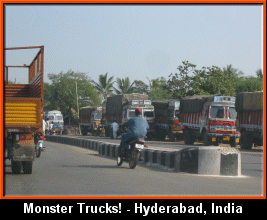 Unfortunately, we did not actually walk around inside
the grounds (my driver indicated that the regular worship hours were over and
that there was nothing up there except for beggars). I had an amazing view of
this temple at night from my hotel...they light up the place with a pale green
light. To add insult to injury, my shiny new digital camera took this
opportunity to run out of battery power. Luckily for me, 4 AA batteries in
India cost just under a dollar...just don't try to take your spare batteries
out of the country in your carry-on luggage: they will be confiscated by Indian
Army security under the pretence that the airlines have instructed them to do
this.
Unfortunately, we did not actually walk around inside
the grounds (my driver indicated that the regular worship hours were over and
that there was nothing up there except for beggars). I had an amazing view of
this temple at night from my hotel...they light up the place with a pale green
light. To add insult to injury, my shiny new digital camera took this
opportunity to run out of battery power. Luckily for me, 4 AA batteries in
India cost just under a dollar...just don't try to take your spare batteries
out of the country in your carry-on luggage: they will be confiscated by Indian
Army security under the pretence that the airlines have instructed them to do
this.
Weekends were about the only time where I felt safe in a car. This is by no means due to a lack of skill on the part of my driver, Syed (in fact, he was incredible). Traffic in Hyderabad is absolutely insane. I've been in countries/cities famous (or infamous) for their drivers such as Caracas, Venezuela, Rome, Italy and even New York City, but nothing....I repeat nothing could have prepared me for the beautifully orchestrated chaos that is driving in India. Scooters (by far the most popular means of transportation), cars, busses (many times with people hanging on to the outside of the bus because the interior is too packed with people), trucks (although these are mercifully kept outside the city during daylight hours), and three-wheeled "auto rickshaws" all compete in death-defying (literally) combat for space on the roads. Let's not forget pedestrians, bicycles, and the ever present cattle (everyone gets out of the way for these - they're sacred to Hindus).
 It's not only the vehicles, it's the pollution that
they produce. Take your worst Los Angeles "spare the air" smog day
and multiply that by about 20 and you'll have what Hyderabad deals with
everyday. In the car, we often passed motorcyclists wearing surgical masks to
try to avoid breathing the smog. The 35 mile trip from the office to the hotel
in the evening was almost too much. The worst culprits were the trucks. Monster
trucks, as I call them...right out of 'Mad Max'. They are taller and wider than
American Semi-trailers, although not quite as long. Every single truck had a
paint scheme involving orange, green and yellow somewhere on the body of the
vehicle. Let's not forget the beads hung from every conceivable place inside
the cab, or the mud flaps with pictures of Hindu Gods. These depictions were
not limited to the mud flaps, either: the front grill of the truck was often
adorned with reliefs of Gods. The most humorous part is the writing: Each truck
had the words "Road King" or "King of the Road" painted on
the front bumper. Most of these vehicles are made either by Tata or Ashok Leyland.
It's not only the vehicles, it's the pollution that
they produce. Take your worst Los Angeles "spare the air" smog day
and multiply that by about 20 and you'll have what Hyderabad deals with
everyday. In the car, we often passed motorcyclists wearing surgical masks to
try to avoid breathing the smog. The 35 mile trip from the office to the hotel
in the evening was almost too much. The worst culprits were the trucks. Monster
trucks, as I call them...right out of 'Mad Max'. They are taller and wider than
American Semi-trailers, although not quite as long. Every single truck had a
paint scheme involving orange, green and yellow somewhere on the body of the
vehicle. Let's not forget the beads hung from every conceivable place inside
the cab, or the mud flaps with pictures of Hindu Gods. These depictions were
not limited to the mud flaps, either: the front grill of the truck was often
adorned with reliefs of Gods. The most humorous part is the writing: Each truck
had the words "Road King" or "King of the Road" painted on
the front bumper. Most of these vehicles are made either by Tata or Ashok Leyland.
I was a little smarter on the journey home: I had a 24 hour layover in Paris. I tried to visit a few old favorites, like the Jardin du Luxembourg. I was also in a shopping mood (despite the fact that I came home from India with way more things than I left with), so I visited Les Halles (which is not exactly a typical tourist destination - it's much like your local mall, Parisian style). After an orgy of scarf buying (don't even ask). I even wandered around Pigalle...no, not for the sex shops...I was looking for guitars, and apparently, this is one of the best places in Europe to buy one. Besides, I took in the Moulin Rouge the last time I was in Paris.
When I finally reached home, I was overjoyed. I had just experienced 2 weeks of foreign sensory overload. It was great to get back to the old familiar sights, sounds and smells of Northern California. Like I said in the introduction, "India was everything I expected, and nothing like I had expected."